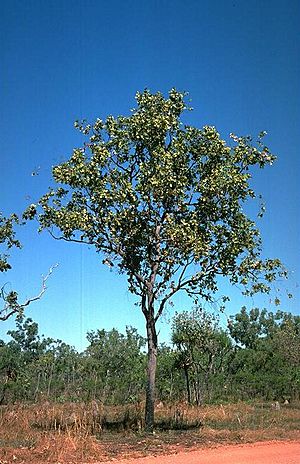Rusty bloodwood facts for kids
Quick facts for kids Rusty bloodwood |
|
|---|---|
 |
|
| Corymbia ferruginea at Kakadu | |
| Scientific classification | |
| Genus: |
Corymbia
|
| Species: |
ferruginea
|
| Synonyms | |
|
Eucalyptus ferruginea Schauer |
|
The Rusty Bloodwood, officially called Corymbia ferruginea, is a special tree that grows only in northern Australia. It gets its common name from its rough, reddish-brown bark. This tree has unique leaves that stay "young-looking" even when the tree is old. It also produces pale yellow flowers and interesting urn-shaped fruits.
Contents
What Does the Rusty Bloodwood Look Like?
The Rusty Bloodwood is usually a thin, spread-out tree. It typically grows to be about 3–12 m (9.8–39.4 ft) tall. This tree has a special woody swelling at its base called a lignotuber. This helps it regrow after fires.
Young plants and new shoots have rusty green leaves. These leaves are hairy and shaped like a wide spear or an egg. They are about 60–140 mm (2.4–5.5 in) long and 25–70 mm (0.98–2.76 in) wide. These leaves are "sessile," meaning they attach directly to the stem without a stalk.
The leaves at the top of the tree are also "juvenile" (young-looking) leaves. They are dull green on both sides and have brown hairs along their veins. These leaves are quite large, about 63–180 mm (2.5–7.1 in) long and 30–90 mm (1.2–3.5 in) wide. They can be sessile or have a very short stalk up to 8 mm (0.31 in) long.
The tree's flower buds grow in groups of three or seven. They are found at the ends of branches on a hairy, rusty-brown stalk called a peduncle. This stalk can be 4–35 mm (0.16–1.38 in) long. Each bud can be sessile or have a short stalk up to 5 mm (0.20 in) long.
Mature buds are oval or pear-shaped, about 7–14 mm (0.28–0.55 in) long and 5–8 mm (0.20–0.31 in) wide. They have a rounded cap, called an operculum, which covers the flower parts.
The Rusty Bloodwood blooms from January to April. Its flowers are a pale creamy yellow color. After flowering, the tree produces woody, urn-shaped fruits. These fruits are about 18–33 mm (0.71–1.30 in) long and 15–29 mm (0.59–1.14 in) wide. The parts that release the seeds stay inside the fruit.
How Did It Get Its Name?
The Rusty Bloodwood was first officially described in 1843. A scientist named Johannes Conrad Schauer gave it the name Eucalyptus ferruginea.
Later, in 1995, two other botanists, Ken Hill and Lawrie Johnson, changed its name. They moved it to a new group of trees called Corymbia, so its full scientific name became Corymbia ferruginea.
There are also two slightly different types, or subspecies, of Rusty Bloodwood. One is the main type, and the other, called Corymbia ferruginea subsp. stypophylla, has smaller leaves with longer stalks.
Where Does the Rusty Bloodwood Grow?
The Rusty Bloodwood tree grows in open forests and woodlands. It prefers shallow, sandy soils that come from sandstone, or deep sandy areas. You can find it across northern Australia. Its range stretches from west of Fitzroy Crossing in Western Australia, all the way east through the northern part of the Northern Territory, to south of Burketown in north-west Queensland.
See also
- List of Corymbia species

